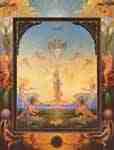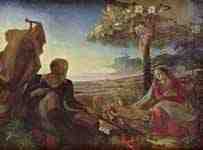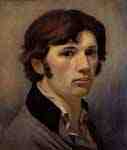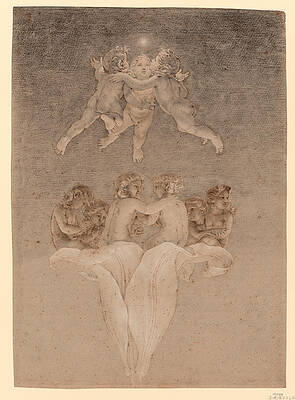Philipp Otto Runge
Paintings





Drawings
Genii on a Lily


Fine Art Prints | Greeting Cards | Phone Cases | Lifestyle | Face Masks | Men's , Women' Apparel | Home Decor | jigsaw puzzles | Notebooks | Tapestries | ...
Philipp Otto Runge (German: [ˈʀʊŋə]; 23 July 1777 – 2 December 1810) was a Romantic German painter and draughtsman. He made a late start to his career and died young, nonetheless he is considered among the best German Romantic painters.
Life and work
Runge was born as the 9th of 11 children in Wolgast, Western Pomerania, then under Swedish rule, in a family of shipbuilders with ties to the Prussian nobility of Sypniewski / von Runge family. As a sickly child he often missed school and at an early age learned the art of scissor-cut silhouettes from his mother, practised by him throughout his life. In 1795 he began a commercial apprenticeship at his older brother Daniel's firm in Hamburg. In 1799 Daniel supported Runge financially to begin study of painting under Jens Juel at the Copenhagen Academy. In 1801 he moved to Dresden to continue his studies, where he met Caspar David Friedrich, Ludwig Tieck, and his future wife Pauline Bassenge. He also began extensive study of the writings of the 17th century mystic Jakob Boehme. In 1803, on a visit to Weimar, Runge unexpectedly met Johann Wolfgang von Goethe and the two formed a friendship based on their common interests in color and art.
In 1804 he married and moved with his wife to Hamburg. Due to imminent war dangers (Napoleonic siege of Hamburg) they relocated in 1805 to his parental home in Wolgast where they remained until 1807. In 1805 Runge's correspondence with Goethe on the subject of his artistic work and color became more intensive. Returning to Hamburg in 1807, he and his brother Daniel formed a new company in which he remained active until the end of his life. In the same year he developed the concept of the color sphere.[1] In 1808 he intensified his work on color, including making disk color mixture experiments. He also published written versions of two local folk fairy tales The fisherman and his wife and The almond tree, later included among the tales of the brothers Grimm. In 1809 Runge completed work on the manuscript of Farben-Kugel (Color sphere), published in 1810 in Hamburg.[2] In the same year, ill with tuberculosis,Runge painted another self-portrait as well as portraits of his family and brother Daniel. The last of his four children was born on the day after Runge's death.[3]
Der Morgen ("Morning", 1808), oil on canvas
Runge was of a mystical, deeply Christian turn of mind, and in his artistic work he tried to express notions of the harmony of the universe through symbolism of colour, form, and numbers. He considered blue, yellow, and red to be symbolic of the Christian trinity and equated blue with God and the night, red with morning, evening, and Jesus, and yellow with the Holy Spirit (Runge 1841, I, p. 17). He also wrote poetry and to this end he planned a series of four paintings called The Times of the Day, designed to be seen in a special building and viewed to the accompaniment of music and poetry. This concept was common to romantic artists, who tried to achieve a "total art", or a fusion between all forms of art. In 1803 Runge had large-format engravings made of the drawings of the Times of the Day series that became commercially successful and a set of which he presented to Goethe. He painted two versions of Morning (Kunsthalle, Hamburg), but the others did not advance beyond drawings. "Morning" was the start of a new type of landscape, one of religion and emotion.
Runge was also one of the best German portraitists of his period; several examples are in Hamburg. His style was rigid, sharp, and intense, at times almost naïve.
Runge and color
Runge’s Farbenkugel (color sphere)
Runge's interest in color was the natural result of his work as a painter and of having an enquiring mind. Among his accepted tenets was that "as is known, there are only three colors, yellow, red, and blue" (letter to Goethe of July 3, 1806). His goal was to establish the complete world of colors resulting from mixture of the three, among themselves and together with white and black. In the same lengthy letter, Runge discussed in some detail his views on color order and included a sketch of a mixture circle, with the three primary colors forming an equilateral triangle and, together with their pair-wise mixtures, a hexagon. He arrived at the concept of the color sphere sometime in 1807, as indicated in his letter to Goethe of November 21 of that year, by expanding the hue circle into a sphere, with white and black forming the two opposing poles. A color mixture solid of a double-triangular pyramid had been proposed by Tobias Mayer in 1758, a fact known to Runge. His expansion of that solid into a sphere appears to have had an idealistic basis rather than one of logical necessity. With his disk color mixture experiments of 1807, he hoped to provide scientific support for the sphere form. Encouraged by Goethe and other friends, he wrote in 1808 a manuscript describing the color sphere, published in Hamburg early in 1810. In addition to a description of the color sphere, it contains an illustrated essay on rules of color harmony and one on color in nature written by Runge's friend Henrik Steffens. An included hand-colored plate shows two different views of the surface of the sphere as well as horizontal and vertical slices showing the organization of its interior (see figure on left). Runge's premature death limited the impact of this work. Goethe, who had read the manuscript before publication, mentioned it in his Farbenlehre of 1810 as "successfully concluding this kind of effort." It was soon overshadowed by Michel Eugène Chevreul's hemispherical system of 1839. A spherical color order system was patented in 1900 by Albert Henry Munsell, soon replaced with an irregular form of the solid.
References
Maltzahn, H. 1940, Philipp Otto Runge's Briefwechsel mit Goethe, Weimar: Verlag der Goethe-Gesellschaft.
Runge, P. O. 1810, Die Farben-Kugel, oder Construction des Verhaeltnisses aller Farben zueinander, Hamburg: Perthes.
Runge, P. O. 1840/41, Hinterlassene Schriften', 2. vols., D. Runge, ed., Hamburg: Perthes.'
External links
P. O. Runge, the artist
[1] Downloadable text of P. F. Schmidt "Philipp Otto Runge; sein Leben und sein Werk", Leipzig: Insel Verlag 1923]
Runge-Haus in Wolgast
Available English translation of "Farben-Kugel" and supporting materials
German masters of the nineteenth century: paintings and drawings from the Federal Republic of Germany, a full text exhibition catalog from The Metropolitan Museum of Art, which contains material on Philipp Otto Runge (no. 70-73)
----
Fine Art Prints | Greeting Cards | Phone Cases | Lifestyle | Face Masks | Men's , Women' Apparel | Home Decor | jigsaw puzzles | Notebooks | Tapestries | ...
----
Artist
A - B - C - D - E - F - G - H - I - J - K - L - M -
N - O - P - Q - R - S - T - U - V - W - X - Y - Z
Retrieved from "http://en.wikipedia.org/"
All text is available under the terms of the GNU Free Documentation License





